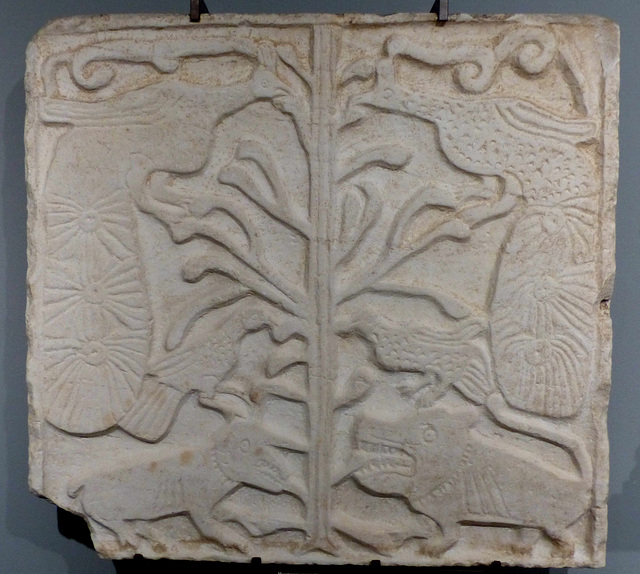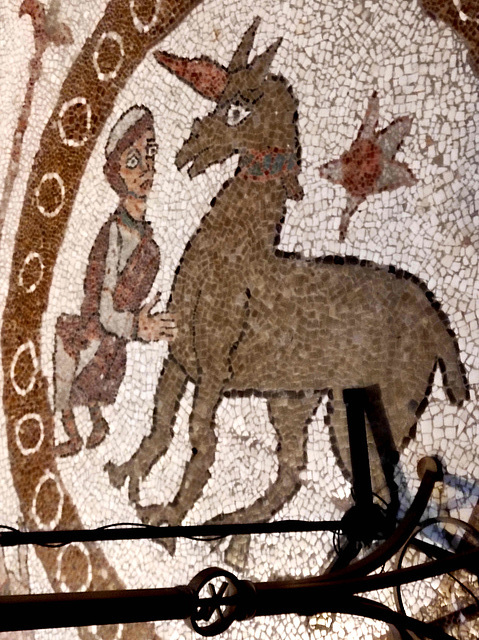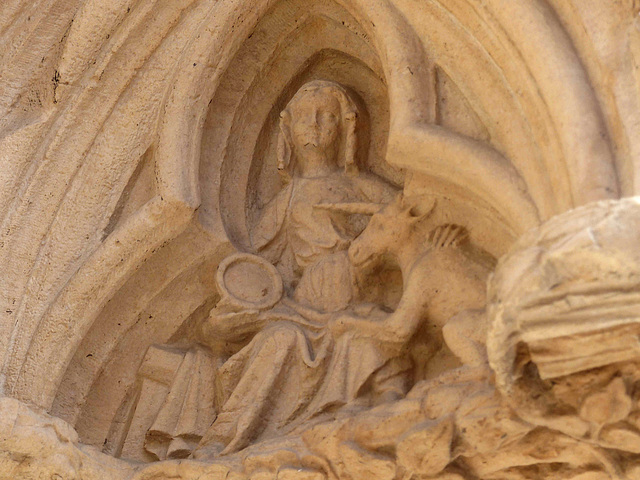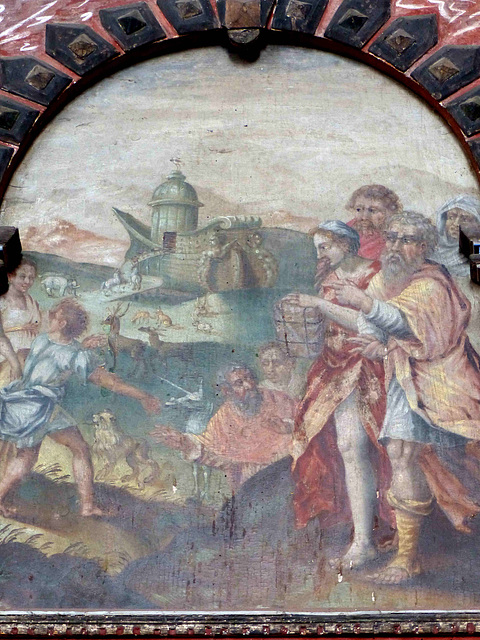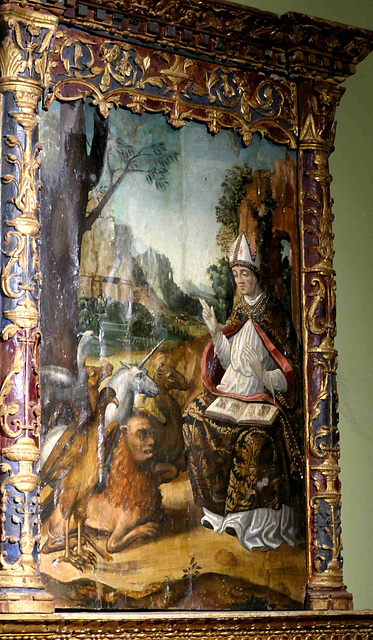
Unicorns
The unicorn is a legendary creature that has been described since antiquity as a very wild beast with a single large, pointed horn projecting from its forehead. It was tamable only by a virgin woman, so sometimes it is seen with Virgin Mary.
Ferrara - Museo della Cattedrale
Ferrara appears first in a document of the Lombard king Desiderius of 753 when he captured the town from the Exarchate of Ravenna. Later the Franks, after routing the Lombards, presented Ferrara to the Papacy in 754. In 988 Ferrara was ceded by the Church to the House of Canossa, but at the death of Matilda of Tuscany in 1115, it became a free commune. During the 12th century, the history of the town was marked by the wrestling for power between the Guelph Adelardi and the Ghibelline Salinguerra families. The Ghibellines won and in 1264 Obizzo II d'Este was proclaimed lifelong ruler of Ferrara. His rule marked the end of the communal period in Ferrara and the beginning of the Este rule, which lasted until 1598.
The museum is located in the former church of San Romano. Benedictine monks were already in the monastery of San Romano in the 10th century, but it was later given to the regular canons of Sant'Agostino.
Fragment of a choir screen, dated 780 - 820
At first sight, I saw two dogs at the bottom. Meanwhile, I think there is a lion and a unicorn.
Ferrara - Museo della Cattedrale
Ferrara appears first in a document of the Lombard king Desiderius of 753 when he captured the town from the Exarchate of Ravenna. Later the Franks, after routing the Lombards, presented Ferrara to the Papacy in 754. In 988 Ferrara was ceded by the Church to the House of Canossa, but at the death of Matilda of Tuscany in 1115, it became a free commune. During the 12th century, the history of the town was marked by the wrestling for power between the Guelph Adelardi and the Ghibelline Salinguerra families. The Ghibellines won and in 1264 Obizzo II d'Este was proclaimed lifelong ruler of Ferrara. His rule marked the end of the communal period in Ferrara and the beginning of the Este rule, which lasted until 1598.
The museum is located in the former church of San Romano. Benedictine monks were already in the monastery of San Romano in the 10th century, but it was later given to the regular canons of Sant'Agostino.
“Allegory of Life” or “Apologist of the Unicorn” c. 1250
Otranto - Duomo di Otranto
Otranto occupies the site of an ancient Greek city. It gained importance in Roman times, as it was the nearest port to the eastern coast of the Adriatic Sea.
After the end of the Roman Empire, it was in the hands of the Byzantine emperors until it surrendered to the Norman troops of Robert Guiscard in 1068. The Normans fortified the city and built the cathedral, that got consecrated in 1088. When Henry VI., son of Emperor Frederick Barbarossa, married Constanze of Sicily in 1186 Otranto came under the rule of the Hohenstaufen and later in the hands of Ferdinand I of Aragón, King of Naples.
Between 1480 and 1481 the "Ottoman invasion" took place here. Troops of the Ottoman Empire invaded and laid siege to the city and its citadel. Legends tell that more than 800 inhabitants were beheaded after the city was captured. The "Martyrs of Otranto" are still celebrated in Italy, their skulls are on display in the cathedral. A year later the Ottoman garrison surrendered the city following a siege by Christian forces and the intervention of Papal forces.
Otranto had been one of the last Byzantine strongholds in Apulia, but finally, Robert Guiscard could take it. It had probably been such a stronghold, as Otranto had hosted an autocephalous bishopric, only dependent on the patriarchal see of Byzantium since 968. So (Roman) Catholicism had to perform something "convincing" for the so-long (Byzantine) Orthodox Christians. One was to erect a huge church. The Otranto Cathedral, seen in the center, was erected over the ruins of a Paleochristian church from 1080 on and was consecrated in 1088. It is 54 meters long by 25 meters wide and is built on 42 monolithic granite and marble columns.
I had returned to Otranto to see the unbelievable, breathtaking mosaic again. It was created by a monk named Pantaleon and his workshop between 1163 and 1165. Pantaleon lived at the monastery San Nicola di Casole, located a few kilometers south of Otranto.
The mosaic covers the nave, both aisles, the apse and the presbytery. This sums up to a total of 1596 m². About 10 000000 (10 million!) "tesserae" were used.
There are scholars, who have counted up to 700 different "stories", that are told here. Though, these "stories" are often disputed, as today's interpretations are mostly very "vague". German historian Carl Arnold Willemsen published the most important book about the mosaic in Italian " L'enigma di Otranto", that since the 1970s is translated into many languages. I followed his theories.
The unicorn was a very rare species in the Middle Ages.
As I have uploaded so many photos taken in Otranto already, I will upload now only a few. If you want to see more click here:
www.ipernity.com/doc/323415/album/1333378
Lyon - Cathédrale Saint-Jean-Baptiste
Colonia Copia Claudia Augusta Lugdunum (now Lyon) was an important Roman city in Gaul. It was the capital of the Roman province of Gallia Lugdunensis. The Christianization took place very early.
In 177, the Christian community sent a letter naming 48 of their number who had been martyred. In 843 it was ceded to Lorraine and then passed to the Kingdom of Burgundy, whose dominion was entrusted to the Archbishop of Lyon by Frederick Barbarossa in 1157. In 1312 Philip the Fair incorporated Lyon into the kingdom of France.
Lyon was the scene of an urban revolt in 1436 when Charles VII increased taxation. The uprising, mainly of small merchants, lasted a total of two months. During the reign of Louis XI. Four fairs were set up, attracting merchants from all over Europe, especially Italy. Lyon became an important center for the spice trade and, more importantly, the silk trade after François I granted the weaving rights, which until then had been an Italian monopoly. Florentine immigrants also made Lyon a financial center for banking and insurance.
-
It is often said that the most beautiful cities are located on rivers. Lyon is situated on two rivers, the Rhone and the Saone, which meet in the south of the city.
-
The Lyon Cathedral was begun in 1180 on the ruins of a 6th-century church and completed in 1476.
In 1245, the church hosted the First Council of Lyon, where the Pope declared Emperor Frederick II deposed. In 1274, the Second Council of Lyon was held in the cathedral, mainly to discuss the union of the Catholic Church with the Greek Orthodox. On August 17, 1316, John XXII was elected pope in the cathedral. He was the second of the Avignon popes.
In 1562 the church was devastated by Calvinist Huguenots. In 1600 the cathedral was the scene of the marriage between King Henry IV and Mary de Medici.
The facade from the 14th and 15th centuries is influenced by the flamboyant Gothic style.
Unicorns were a very rare species in medieval times. And they still are.
Tangermünde - St. Stephan
Tangermünde Castle was first mentioned in 1009 as "civitate Tongeremuthi" because this is where the Tanger (Tongera) flows into the Elbe. The city was first mentioned in 1275.
From 1373 to 1378 Tangermünde was the second seat of Emperor Charles IV, who appointed his 12-year-old son Wenzel Elector of Brandenburg in 1373. After the death of Emperor Charles IV, there was a turbulent development in the Mark, until the Hohenzollerns were enfeoffed with the Mark as electors in 1415 and initially resided in Tangermünde.
The heyday of the Hanseatic city was the 15th century, when the city gates and the town hall were built in the North German brick Gothic style. At this time, St. Stephen's Church was expanded into a Gothic hall church. The city lost the Elector's favor after the uprising of 1488, when the citizens rebelled against the beer tax.
In 1617 the city burned down almost completely. After the fire, many magnificent half-timbered houses were built. Due to the Thirty Years' War, however, the city became a rather insignificant country town.
-
The predecessor of St. Stephan was a Romanesque basilica. It was in existence by 1188. Parts of this original building were reused in the construction of the present church. The transept of the former building gave the width of the new nave. Emperor Charles IV, who lived in Tangermünde between 1373 and 1378, founded a house of Augustinian Canons, to which he gave the church as a source of income. The canons conducted the services.
During the late Middle Ages the construction took place in several phases of today's triple-aisled Gothic hall church. Firstly, after 1350, the northern wall of the nave and the southern wall were built, and in about 1405, the roof and the rib vaults. The prominent octagonal pillars are unusual. The south tower remains uncompleted to this day. In 1450 work began on the construction of the new choir, followed by the outside walls of the new ambulatory and also the arms of the transept. Only then was the old choir removed. The choir was roofed in 1475. The city-wide fire from 1617 damaged the church and the top part of the north tower collapsed. It was not restored until after 1714, when the tower received its present Baroque roof.
A "Biblia Pauperum" (Bible for the poor) was attached to the north gallery of the church in 1620. In this way, the parishioners who could not read were able to experience the stories of the Bible in pictures.
Noah's Ark. In the backdrop the elephants are approaching the ark.
Burgos - Catedral de Burgos
In the 7th/8th century, the area was reconquered from the hands of the Moors by the kings of Asturias. A castle was built in 884 on the orders of King Alfonso III. Burgos became the coronation city of the kings of Castile in the 11th century, which underlines its special importance. After the conquest of Toledo by Alfonso VI. (1085). The city became the see of a Diocese and was a major stop for pilgrims to Santiago de Compostela. Burgos lost its importance a little, but the city remained an important economic, cultural, and political center in northern Spain. The Convento de San Pablo was a Dominican monastery founded in 1224 that existed until 1835.
The construction of the cathedral was ordered by King Ferdinand III of Castile and the Bishop of Burgos. Ferdinand had just married Barbarossa´s granddaughter Beatrice of Swabia (aka "Elisabeth of Swabia") and wanted a cathedral, reflecting his new role in the European power game.
The former Romanesque cathedral was demolished in 1221, and the construction of the new Gothic started under the guidance of a French architect. After nine years, the chevet was completed and the high altar was consecrated. Then the construction stopped for about 200 years.
Attending the Council of Basel (aka "Council of Florence") in 1435 bishop Alfonso de Cartagena saw the elegant towers of the Basel Minster. When he returned to Burgos he was accompanied by German architect Johannes von Köln (aka "Juan de Colonia"), who probably knew the blueprints of the towers, planned for the Cathedral of Cologne. Under his guidance, the towers of the Cathedral were completed in open tracery. He was followed on the construction site by his son Simon de Colonia. Francisco de Colonia, Simon's son, continued the work and created the Pellejería-Portal. This was a family business.
As I have uploaded many photos of the cathedral before, I will only add a few for now.
A unicorn! Depicted on a Flemish tapestry
Salamanca - Catedral Nueva
Salamanca is a "real city" with a population of more than 140.000 inhabitants.
Under Roman and Visigothic rule called “Helmantica,” the city developed into an important trading center. In the 8th century, Salamanca was taken by the Moors, but in 939 it became Christian again as a result of the Battle of Simancas. Salamanca became a border town to the Islamic south of the Iberian Peninsula and was subsequently exposed to constant attacks, which resulted in depopulation and only after the conquest of Toledo by Alfonso VI. León's rule ended in 1085. In 1102 the period of repopulation began. The Christian new settlers rose against Castile-León in 1162 and called on Portugal for help in 1163, which occupied Salamanca for two years.
Salamanca experienced its heyday in the 16th century. In 1524, the construction of the church and monastery of San Esteban began and at the same time, the new cathedral was built.
The "New Cathedral" ("Catedral Nueva") is, together with the "Old Cathedral" ("Catedral Vieja"), one of the two cathedrals of Salamanca. It is the seat of the Diocese of Salamanca.
Following the Reconquista, the Salamanca grew in population and prosperity. The old Romanesque cathedral no longer met the size and representational demands of the bishop, university, and city. In 1513, construction began on the ew bishop's church, which was designed to have enormous dimensions. The northern transept arm of the old church was demolished for this purpose. The ceremonial consecration of the new cathedral did not take place until 1733 after a long, eventful construction history. During the Lisbon earthquake of 1755, the central dome and the bell tower collapsed. The reconstruction was completed by 1762.
The center of the portal (prev. upload) shows the Adoration of the Shepherds (left) and the Adoration of the Magi (right). At the top right, in the innermost archivolt, a unicorn gallops.
Sigüenza - Museo Diocesano de Arte Antiguo
Pliny the Elder mentions Segontia in the 1st century AD in his work "Naturalis Historia" as a Celtiberian settlement. The area was taken by the Romans in the Numantine War (154-133 BC). After the end of the Western Roman Empire, the city was conquered by the Visigoths, who also founded the diocese of Sigüenza in 589. Taken over by the Moors around 712, the Christians reconquered the city in 1123. The construction of the cathedral began only a short time later, but it would take several centuries to complete. Today Sigüenza is a town with a population of about 4500.
The Visigoths built a small castle in the 5th century above the town. The Moors built a large fortified castle in the early 8th century. It was enclosed by a defensive wall providing an area known as the medina. In 1124, the castle was retaken by Bernard of Agen allowing Simón Girón de Cisneros to build an episcopal palace there. In the 15th century, the castle was strengthened by the bishops to protect it from attacks from Aragon and Navarre.
Saint Blaise was not only a healer of bodily ailments (the "Blessing of the Throats" is connected to him), but he is said to have healed animals, who came to him on their own for his assistance. He even healed very rare and strange animals - like unicorns.
Winchester - Cathedral
Winchester, today a town with a population of about 40.000, played an important role in the history of England. In the 10th and early 11th centuries, Winchester was the capital of England and before that the capital of the Anglo-Saxon kingdom of Wessex. The Romans already knew the place under the name "Venta Belgarum".
In the middle of the 9th century, St Swithin was Bishop of Winchester. At the end of the 9th century, the city also became part of a number of fortifications along the south coast of England, built by Alfred the Great.
Winchester remained the capital of Wessex and later England until after the Norman Conquest, when the Normans chose London as their capital in 1066.
Jews lived in Winchester from at least 1148, and in the 13th century the Jewish community was one of the most important in England. There were a series of blood libel claims against the Jewish community in the 1220s and 1230s, which likely was the cause of the hanging of the community's leader, Abraham Pinch, in front of the synagogue. Simon de Montfort ransacked the Jewish quarter in 1264, and in 1290 all Jews were expelled from England.
A pre-Norman cathedral was founded in 642 on a site immediately north of the present one. This building became known as the Old Minster. It became part of a monastic settlement in 971 and was demolished in 1093. Edward the Confessor was crowned in the Old Minster in 1043.
The cathedral in its present form was built between 1079 and 1532 and is dedicated to numerous saints, in particular Swithun of Winchester. It has a very long and very wide nave, an early English transept, Norman transepts and a tower. With a total length of 170 metres, it is probably the longest medieval cathedral in Europe.
When William the Conqueror invaded England in 1066, he began to install his own bishops in place of the Anglo-Saxon bishops. William installed his friend and relative Walkelin as the first Norman Bishop of Winchester in 1070, and nine years later Walkelin began the construction of a huge Norman cathedral. The new cathedral was consecrated with the completion of the east end in 1093, and the many tombs of Saxon kings moved from the Old Minster into the new cathedral. Then the demolition of the New and Old Minsters began, and quickly progressed, leaving virtually no remains. The outline of the Old Minster can still be seen today to the north of the present nave.
The first alteration to Walkelin's cathedral was in 1202 when Bishop Godfrey de Luci started construction of a new Early English retrochoir, this resulted in the demolition of the Norman apse.
In 1346, Bishop Edington had the Norman west front demolished and began building a new Perpendicular Gothic facade, featuring a huge west window, which still stands today. Edington also began renovation of the nave. Master mason William Wynford remodelled the massive Norman nave into a soaring Perpendicular Gothic masterpiece.
One of the rare, extinct golden unicorns
Jump to top
RSS feed- Latest items - Subscribe to the latest items added to this album
- ipernity © 2007-2024
- Help & Contact
|
Club news
|
About ipernity
|
History |
ipernity Club & Prices |
Guide of good conduct
Donate | Group guidelines | Privacy policy | Terms of use | Statutes | In memoria -
Facebook
Twitter

